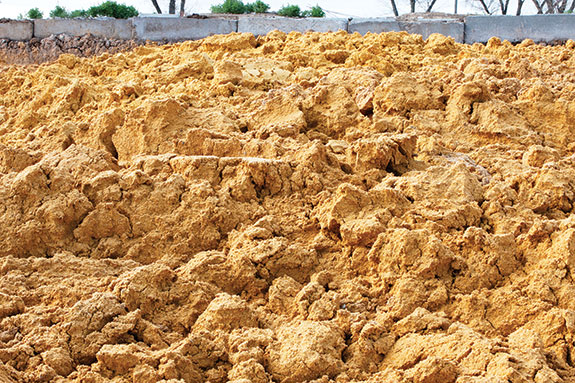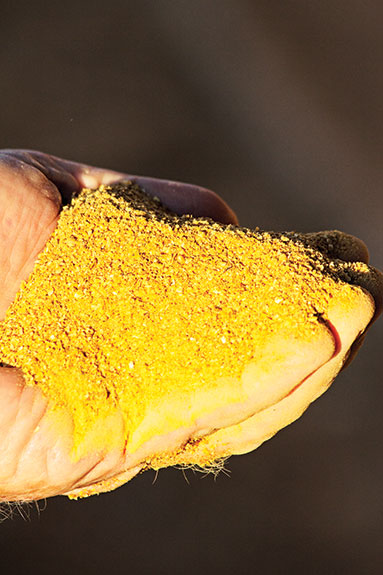Distillers grains are the byproduct of distillation and fuel ethanol production. They have a long history of being fed to livestock.
The first study about feeding distillers grains to cattle was published in 1907.
The tremendous growth of the ethanol industry in the past 20 years has greatly increased the supply of distillers grains to be used as a feedstuff.
All distilled spirits go through at least two procedures: fermentation and distillation. Fermentation is where alcohol is produced; distillation is where the alcohol is separated and removed.
In order for fermentation to occur, two things are needed: a raw material in liquid form that contains sugar, followed by the addition of yeast.
Yeast is a living organism that feeds on sugar; the byproduct of this consumption is alcohol and carbon dioxide (CO2).
A simple formula for fermentation is:
YEAST + SUGAR = ALCOHOL + CO2
The ethanol is separated and the remaining liquid is centrifuged. The residue is called wet distillers grains (WDG) and usually has 30 to 35 percent dry matter (DM).
The liquid is partially dried and becomes condensed distillers solubles (CDS).
Most distilleries add the CDS back to the WDG making wet distillers grains with soluble (WDGS). This product is either fed as-is or dried, producing dried distillers grains with soluble (DDGS).

When grains are fermented to alcohol, approximately one-third of the original (DM) is recovered in byproducts.
Most research has focused on distillers grains as an alternative protein source. However, in addition to their protein content, corn byproducts are also an excellent source of energy, attributed to their high content of digestible neutral-detergent fiber (NDF) and fat.
Distillers grains may contain 40 to 45 percent NDF, which is highly digestible. But despite its fiber content, distillers grains is comprised of mostly small particles, contributing less than 15 percent physically effective fiber to the diet.
Extensive heating of distillers grains during the drying process can alter the nutrient availability, especially protein, in DDS and DDGS.

The color of distillers grains appears to be associated with the amount of acid detergent insoluble nitrogen (ADIN).
Good, high-quality distillers grains will have a honey-golden to caramelized-golden color.
Color progressing toward dark coffee grounds is an indicator of excessive heating during the drying process and the potential for high levels of ADIN.
Wet corn distillers grains with solubles (WDGS) is an excellent feed for finishing cattle.
Research at Iowa State University and the University of Nebraska has shown that WDGS can be added to corn-based diets at levels ranging from 10 to 40 percent of total ration dry matter.
Results indicate improved feed conversion, less problems with acidosis, and the quality and yield grade of carcasses from animals fed WDGS is similar to those fed corn grain.
Dried distillers grains with solubles (DDGS) is also palatable and readily consumed by finishing cattle.
DDGS has an apparent energy value equal to corn grain. Feeding this product does not change quality or yield grade in the carcass.
DDGS is also an excellent feed for growing Holstein steers. It can be fed from 10 to 40 percent of total ration DM in rations for steers 425 to 700 pounds, without affecting feed intake or gain.
Condensed distillers grains with solubles (CDS) is a liquid typically containing 30 percent DM.
When CDS is fed to finishing cattle at 10 percent or less of total ration DM, its apparent energy value is equal to or somewhat greater than corn grain. Higher levels may reduce feed intake.
Comparing the feeding of distillers wet and dry grains, recent research conducted at the University of Nebraska in dairy cows found no differences in feed intake or milk production.
However, on-farm observations indicate there may be an advantage to feeding it wet in situations where the other ration ingredients are very dry, thus minimizing sorting and improving ration palatability.
Dried products can be stored for extended periods of time, can be shipped greater distances more economically and conveniently than wet and can be easily blended with other dietary ingredients. However, feeding wet distillers grains avoids the costs of drying the product.
A fresh supply of product is best obtained approximately every five to seven days. Surface molds occasionally occur, and these can result in feed losses or poor performance.
Use of DDGS at 15 to 20% of ration DM may be economical, but requires caution. Adequate dietary degradable protein should be supplied from other sources.
References omitted due to space but are available upon request. Click here to email an editor.
PHOTOS
TOP: Studies show that wet distillers grain with solubles can be added to corn-based diets from 10 to 40 percent of total ration dry matter.
BOTTOM: Good, high-quality distillers grains will have a honey-golden to caramelized-golden color. Photos by staff.








